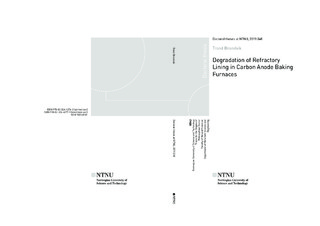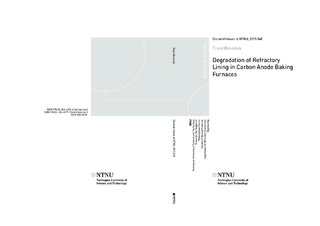| dc.contributor.advisor | Grande, Tor | |
| dc.contributor.advisor | Ratvik, Arne Petter | |
| dc.contributor.advisor | Wang, Zhaohui | |
| dc.contributor.author | Brandvik, Trond | |
| dc.date.accessioned | 2020-01-15T16:30:44Z | |
| dc.date.available | 2020-01-15T16:30:44Z | |
| dc.date.issued | 2019 | |
| dc.identifier.isbn | 978-82-326-4277-9 | |
| dc.identifier.issn | 1503-8181 | |
| dc.identifier.uri | http://hdl.handle.net/11250/2636522 | |
| dc.description.abstract | Primary aluminium metal is produced by electrochemical reduction of Al2O3 at ~960 ºC, during which large amounts of carbon anodes are consumed. The anodes are thus constituting an important part of the production process. During production of carbon anodes, petroleum coke, recycled anodes and coal tar pitch are mixed and formed into green anodes prior to heat treatment in the anode baking furnace. The heating process is important for obtaining the desired anode properties, and proper operation of the furnaces is thus of great importance for the quality of the aluminium metal product. Aluminosilicate refractory materials are the major building component of the anode baking furnace. During the baking of carbon anodes, the refractory materials in the furnace are exposed to large temperature variations and a harsh chemical environment. This leads to unwanted degradation of the refractory lining, ultimately causing the need for replacement of material. This PhD work has been focused on examining the degradation of refractory lining, with the aim to describe degradation mechanisms. Spent refractory lining from two industry furnaces have been characterized by X-ray diffraction, scanning electron microscopy and measurements of density and open porosity. Changes in density, open porosity and microstructure were linked to the operational conditions of the furnace. Next, the chemical composition of the pit gas atmosphere was measured by FTIR analysis during normal operation of the furnace. Changes in concentration of CO, CO2, H2O, CH4 and HF were measured and linked to the observed degradation patterns of the refractory lining. Last, a densification mechanism was proposed based on the experimental data and verified by FEM modeling in COMSOL Multiphysics. | nb_NO |
| dc.language.iso | eng | nb_NO |
| dc.publisher | NTNU | nb_NO |
| dc.relation.ispartofseries | Doctoral theses at NTNU;2019:340 | |
| dc.relation.haspart | Paper 1: Brandvik, Trond. A Thermodynamic Assessment of the Chemical Durability of Refractory Lining in Anode Baking Furnaces. ICSOBA 2016 - The International Committee for Study of Bauxite, Alumina & Aluminium | nb_NO |
| dc.relation.haspart | Paper 2: Brandvik, Trond; Wang, Zhaohui; Ratvik, Arne Petter; Grande, Tor. Investigation of Spent Refractory Lining in an Anode Baking Furnace. The Minerals, Metals & Materials Series 2017 (210819) s. 1281-1288
https://doi.org/10.1007/978-3-319-51541-0_153 | nb_NO |
| dc.relation.haspart | Paper 3: Brandvik, Trond; Ratvik, Arne Petter; Grande, Tor. Effects of Water Cooling of Green Anodes on Anode Furnace Operation. The International Committee for Study of Bauxite, Alumina & Aluminium Conference 2018; | nb_NO |
| dc.relation.haspart | Paper 4: Brandvik, Trond; Wang, Zhaohui; Ratvik, Arne Petter; Grande, Tor. Autopsy of refractory lining in anode kilns with open and closed design. International Journal of Applied Ceramic Technology 2019 ;Volum 16. s. 602-613
https://doi.org/10.1111/ijac.13108 | nb_NO |
| dc.relation.haspart | Paper 5: Brandvik, Trond; Gaertner, Heiko; Ratvik, Arne Petter; Grande, Tor; Aarhaug, Thor Anders. In situ monitoring of pit gas composition during baking of anodes for aluminum electrolysis. Metallurgical and materials transactions. B, process metallurgy and materials processing science 2019 ;Volum 50.(2) s. 950-957
https://doi.org/10.1007/s11663-018-1500-8 | nb_NO |
| dc.title | Degradation of Refractory Lining in Carbon Anode Baking Furnaces | nb_NO |
| dc.type | Doctoral thesis | nb_NO |
| dc.subject.nsi | VDP::Technology: 500::Materials science and engineering: 520 | nb_NO |

